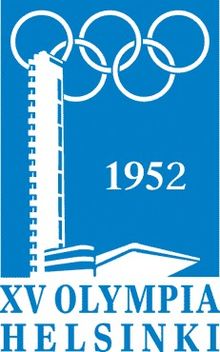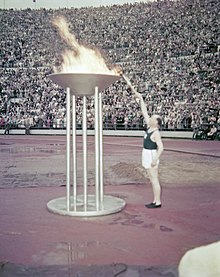Finland at the Olympics
![]()
.png)
FIN
![]()

FIN
Finland's Olympic history began in 1906 with the private participation of four Finnish athletes in the unofficial 1906 Olympic Intermediate Games in Athens. In 1907, Baron Reinhold Felix von Willebrand of Finland was elected to the International Olympic Committee (IOC), and shortly thereafter Finland established its National Olympic Committee, Suomen Olympiakomitea, and officially participated in the 1908 Summer Olympics in London for the first time. Until the 1912 Summer Games, Finland was still part of the Russian Empire as an Autonomous Grand Duchy; however, the results were separated from those of Russia. Only in 1920 Finland took part as an independent country and since then it has always been present at all Summer Olympic Games and the Winter Games which took place from 1924 on. Youth athletes competed in all Youth Olympic Games held so far.

Logo of the Summer Olympics 1952 Helsinki
General
Finland is one of the nations that have won at least one medal in all their participations. Finland is one of the world leaders in cross-country skiing. With 76 medals won, the country is second only to Norway in the Olympic ranking of this sport. Cross-country skiing is Finland's most successful winter sport and the third most successful sport overall. Finland does even better in athletics with 114 medals and in wrestling with 83 medals. In wrestling Finland ranks fourth behind the USA, the Soviet Union and Sweden, and the same in athletics behind the USA, the United Kingdom and the Soviet Union.
The first Finnish Olympic team competed in 1908 and consisted of 68 participants. The members of the free rifle three-position shooting team, Emil Nässling, Frans Nässling, Gustaf Nyman, Heikki Huttunen, Voitto Kolho and Huvi Tuiskanen, were the first Finnish Olympians on July 9, 1908. On July 8, 1912, swimmers Tyyne Järvi and Regina Kari were the first Finnish women to participate in the Olympics. The first winter athletes were figure skaters, who competed in the 1920 Summer Olympics. Sakari Ilmanen competed on April 25, 1920. The first female winter athlete was Ludowika Jakobsson the next day, who won the pairs skating event with her husband Walter Jakobsson, making her the first Finnish woman to win a medal or become an Olympic champion. Her husband Walter was the first male winter sportsman who could win a medal and became Olympic champion at the same time.
The first men's medal was won by the all-around gymnastics team on July 16, 1908. On July 22, wrestler Verner Weckman became the first Finnish Olympic champion with his victory in the light heavyweight Greco-Roman style. The first woman to win a medal at the Summer Games was javelin thrower Kaisa Parviainen on July 31, 1948, who won silver. The first female Olympic champion at the Summer Games was canoeist Sylvie Saimo on 28 July 1952, who won in the single kayak.
The most successful Olympian is the long-distance runner Paavo Nurmi, who won a total of nine gold and three silver medals between 1920 and 1928. This makes him the most successful track and field athlete at the Olympic Games to date, and he is the 8th most successful athlete ever. The most successful winter athlete is speed skater Clas Thunberg with five gold, one silver and one bronze medal between 1924 and 1928. The most successful woman is cross-country skier Marja-Liisa Kirvesniemi. She won three gold and four bronze medals between 1976 and 1994.
The ski jumper Janne Ahonen has competed in the most Olympic Games. He competed seven times between 1994 and 2018. Another ski jumper from Finland holds the record as the youngest Olympic champion at Winter Games. Toni Nieminen set this record in 1992 when he won gold from the large hill at the age of 16 years and 259 days.
Most Finnish athletes competed in the 1952 Summer Games at home. In Helsinki, 258 Finns took part. The most winter athletes were present in 2018, the team included 100 athletes.
With 37 medals Finnish athletes won the most medals in Paris 1924. Four years earlier in Antwerp they won three medals less but managed one Olympic victory (15) more than in Paris (14). Finnish winter athletes won 13 medals in Sarajevo in 1984. With four gold medals they achieved as many Olympic victories as in 1924, 1988 and 2002.
Finland has a voting IOC member in former track and field athlete Sari Essayah. Essayah competed in walking in 1992 and 1996. She finished 4th in the 10 kilometres in 1992.
Olympic Games bids and alignments
Applications
Summer Games
So far, Finland has twice applied to host the Summer Olympics. As early as 1928, the first plans were made to bring the Olympic Games to Finland, which is why a foundation was established to build the Helsinki Olympic Stadium. The first bid was made at the 1932 IOC Session in Los Angeles for the 1940 Summer Olympics. While waiting for the IOC's decision, construction began on the stadium, designed by Yrjö Lindegen and Toivo Jäntti, on 12 February 1934. At the 1936 IOC session in Berlin, 26 of the members present decided in favour of Finland, 21 in favour of Japan. Absentee members had previously voted by postal ballot, resulting in a vote of 36 to 27 for Japan, after which the IOC awarded the Games to Tokyo. Nevertheless, construction on the stadium continued and was nearly completed by the summer of 1938. When Japan then dropped out as host due to the Second Sino-Japanese War, Finland, as runner-up, accepted the offer to host the Games after all in June 1938. The official inauguration of the Olympic Stadium took place on 12 June 1938; the eastern wall and missing rows of seats were completed later that year. In the autumn of 1939, the Second World War broke out and, as a result, the Winter War. The construction work on the swimming stadium was interrupted by this, but the Olympic village in Koskelantie with accommodation for 3,200 athletes was still completed by 1940. On April 23, 1940, Finland also decided not to host the Games due to the war. The 1940 Summer Games were completely cancelled.
After the end of the war, Finland decided to reapply on 23 April 1947 under the leadership of Erik von Frenckell, the president of the organising committee. In the vote in Stockholm on 17 June 1947, Helsinki received the majority of the votes and thus the IOC awarded it the hosting of the 1952 Summer Olympics. Building on the preparatory work of the previous bid, the organising committee developed its plans for the 1952 Summer Games. The majority of the events were to be held around the Olympic Stadium, only the pentathlon and some football matches were moved to cities outside Helsinki (Hämeenlinna, Turku, Tampere, Kotka and Lahti). The Olympic Stadium itself was slightly expanded and received 20,000 more seats on wooden stands, increasing its capacity to 70,000. In addition, changing rooms, showers, etc. had to be installed for the female athletes, for whom competitions were now also offered, and some of the venues had to be modernised. The interrupted construction work on the swimming stadium was continued in 1947. For the rowing competitions a stadium had been built in Taivallahti in 1940, but in 1952 it no longer met the regulations. Therefore, a temporary stadium was built in Meilahti. The Olympic village built in 1940 had meanwhile been released for private use and was inhabited by 500 families, so a new one was built in Käpylä. Originally designed for 3,400 residents, the plans were revised again due to the large number of participants at the 1948 Summer Olympics in London. The complex eventually provided space for 4,800 people.
Winter Olympics
Finland put together five applications to host for Winter Games. Lahti applied to host the 1964 Games, but failed without a single vote. In the bid to host the 968 Winter Games, they were eliminated in the second round, and in the bid to host the 1972 Winter Games, they were eliminated in the first round with seven votes. Tampere's bid to host the 1976 Winter Games was eliminated with eight votes in the second ballot. Helsinki's bid to host the 2006 Winter Games was not accepted by the IOC.
Alignment
The 15th Olympic Games were held in Helsinki from 19 July to 3 August 1952. A total of 4955 athletes (4436 men, 519 women) from 69 countries, including the Soviet Union for the first time, competed in 149 events in 17 sports. The Olympic flame was lit by Paavo Nurmi, the Olympic oath was spoken by gymnast Heikki Savolainen.

Paavo Nurmi at the lighting of the Olympic flame
Search within the encyclopedia